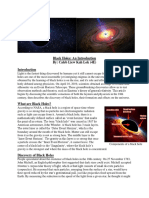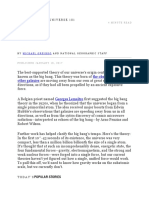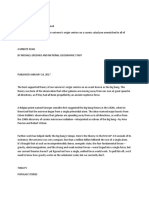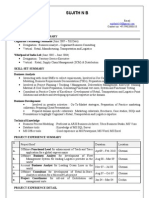Space
Space
Uploaded by
bhatiaharryjassiCopyright:
Available Formats
Space
Space
Uploaded by
bhatiaharryjassiOriginal Title
Copyright
Available Formats
Share this document
Did you find this document useful?
Is this content inappropriate?
Copyright:
Available Formats
Space
Space
Uploaded by
bhatiaharryjassiCopyright:
Available Formats
Space
TECH SPACEFLIGHT SCIENCE & ASTRONOMY SEARCH FOR LIFE SKYWATCHING ENTERTAINMENT SHOP
space
TECH SPACEFLIGHT SCIENCE & ASTRONOMY SEARCH FOR LIFE SKYWATCHING ENTERTAINMENT SHOP
TRENDING:Comet ISON// Skywatching Guide// Mars Rover Curiosity// Solar Flares // Space Photos// Space Videos// Telescopes for Beginners
Einstein's Theory of General Relativity
by Nola Taylor Redd, SPACE.com Contributor | September 18, 2012 06:52pm ET
109
23
36 Share
29
In 1905, Albert Einstein determined that the laws of physics are the same for all non-accelerating observers, and that the speed of light in a vacuum was independent of the motion of all observers. This was the theory of special relativity. It introduced a new framework for all of physics and proposed new concepts of space and time.
Theory of General Relativity
Einstein's theory of general relativity predicted that the space-time around Earth would be not only warped but also twisted by the planet's rotation. Gravity Probe B showed this to be correct. Credit: NASA View full size image
Einstein then spent ten years trying to include acceleration in the theory and published his theory of general relativity in 1915. In it, he determined that massive objects cause a distortion in space-time, which is felt as gravity.
The tug of gravity
Two objects exert a force of attraction on one another known as "gravity." Even as the center of the Earth is pulling you toward it (keeping you firmly lodged on the ground), your center of mass is pulling back at the Earth, albeit with much less force. Sir Isaac Newtonquantified the gravity between two objects when he formulated his three laws of motion. Yet Newton's laws assume that gravity is an innate force of an object that can act over a distance.
Albert Einstein, in his theory of special relativity, determined that the laws of physics are the same for all non-accelerating observers, and he showed that the speed of lightwithin a vacuum is the same no matter the speed at which an observer travels. As a result, he found that space and time were interwoven into a single continuum known as space-time. Events that occur at the same time for one observer could occur at different times for another.
As he worked out the equations for his general theory of relativity, Einstein realized that massive objects caused a distortion in space-time. Imagine setting a large body in the center of a trampoline. The body would press down into the fabric, causing it to dimple. A marble rolled around the edge would spiral inward toward the body, pulled in much the same way that the gravity of a planet pulls at rocks in space. [VIDEO: Gravity: Space-Time Warp]
Experimental evidence
Although instruments can neither see nor measure space-time, several of the phenomena predicted by its warping have been confirmed.
Einstein's Cross
Einstein's Cross is an example of gravitational lensing. Credit: NASA and European Space Agency (ESA) View full size image
Gravitational lensing: Light around a massive object, such as a black hole, is bent, causing it to act as a lensfor the things that lay behind it. Astronomers routinely use this method to study stars and galaxies behind massive objects.
Einstein's Cross, a quasar in the Pegasus constellation, is an excellent example of gravitational lensing. The quasar is about 8 billion light-years from Earth, and sits behind a galaxy that is 400 million lightyears away. Four images of the quasar appear around the galaxy because the intense gravity of the galaxy bends the light coming from the quasar.
Changes in the orbit of Mercury: The orbit of Mercury is shifting very gradually over time, due to the curvature of space-time around the massive sun. In a few billion years, it could even collide with the Earth.
Frame-dragging of space-time around rotating bodies: The spin of a heavy object, such as Earth, should twist and distort the space-time around it. In 2004, NASA launched the Gravity Probe B. The precisely calibrated satellite caused the axes of gyroscopes inside to drift very slightly over time, a result that coincided with Einstein's theory.
Gravitational redshift: The electromagnetic radiation of an object is stretched out slightly inside a gravitational field. Think of the sound waves that emanate from a siren on an emergency vehicle; as the
vehicle moves toward an observer, sound waves are compressed, but as it moves away, they are stretched out, or redshifted. Known as the Doppler Effect, the same phenomena occurs with waves of light at all frequencies. In 1959, two physicists, Robert Pound and Glen Rebka, shot gamma rays of radioactive iron up the side of a tower at Harvard University and found them to be minutely less than their natural frequency due to distortions caused by gravity.
Gravitational waves: Violent events, such as the collision of two black holes, are thought to be able to create ripples in space-time known as gravitational waves. The Laser Interferometer Gravitational Wave Observatory is presently searching for the first signs of these tell-tale indicators.
Nola Taylor Redd, SPACE.com Contributor
Related: Video: Flying Space-time's Warps and Twists Top 10 Strangest Things in Space Twisted Physics: 7 Mind-Blowing Findings
YOU MIGHT ALSO LIKE
Hubble Telescope Finds Source of Cosmic Stream Near Milky Way (Photos)
Hubble Telescope Finds Source of Cosmic Stream Near Milky Way (Photos)
Are We All Martians? Tool Could Help Detect Earth-Like Life on Mars
Are We All Martians? Tool Could Help Detect Earth-Like Life on Mars
Neptune's Moons: 14 Discovered So Far
Neptune's Moons: 14 Discovered So Far
Big Asteroid Flies By Earth Tonight: How to Watch Live
Big Asteroid Flies By Earth Tonight: How to Watch Live
Playing with space: using colour to make rooms look bigger
Sponsored
Playing with space: using colour to make rooms look bigger
Let's Colour
Why It Will Be Difficult to Create Secure Email
Sponsored
Why It Will Be Difficult to Create Secure Email
BusinessWeek
Where in the World Is Your Data?
Sponsored
Where in the World Is Your Data?
It's All About Data Recovery
THE BROKEN LANDS: the Cover, and a first introduction to Sam and Jin
Sponsored
THE BROKEN LANDS: the Cover, and a first introduction to Sam and Jin
The Clockwork Foundry
Hubble Telescope Finds Source of Cosmic Stream Near Milky Way (Photos)
Are We All Martians? Tool Could Help Detect Earth-Like Life on Mars
Neptune's Moons: 14 Discovered So Far
Big Asteroid Flies By Earth Tonight: How to Watch Live
Playing with space: using colour to make rooms look bigger
Why It Will Be Difficult to Create Secure Email
Where in the World Is Your Data?
THE BROKEN LANDS: the Cover, and a first introduction to Sam and Jin
Latest on Einstein's Theory of General Relativity
abstract night acceleration speed, motion.
Einstein's Cosmic Speed Limit Passes New Test
Space Shuttle and Hubble Destroyed In 'Gravity' Trailer | Video
Space Shuttle and Hubble Destroyed In 'Gravity' Trailer | Video
Black holes theory and Loop Quantum Gravity
Space-Time Loops May Explain Black Holes
black hole particles escaping
The Strangest Black Holes in the Universe
Time DVDs
Experts Use Tech Gadgets to Explain the Nature of Time
White Dwarf Star Collects Planet Debris | Animation
White Dwarf Star Collects Planet Debris | Animation
3D visualization of gravitational waves produced by two orbiting black holes.
The Hunt for Elusive Gravity Waves Heats Up
An illustration of an atom interferometer spacecraft mission to hunt for gravity waves.
Quantum Mechanics Trick May Detect Invisible Gravity Waves
Gravitational Waves
The Search for Gravity Waves Illustrated (Gallery)
Pulsar and White Dwarf Orbit Artist Impression space wallpaper
Odd Couple | Space Wallpaper
Artist's Impression of the J0348+0432 System.
Einstein's Gravity Theory Passes Toughest Test Yet
Strange Star Pair Confirms Einstein | Video
Strange Star Pair Confirms Einstein | Video
Dead Star Bends Companion's Light
Super-Dense Dead Star Warps Light of Stellar Companion (Video)
VA212 Lift Off
Huge Rocket Launch Lights Up Tropical Night Sky (Photo)
Galaxy NGC 4214 is dominated by a huge glowing cloud of hydrogen gas in which new stars are being born. A heart-shaped hollow possibly galaxy NGC 4214s most eye-catching feature can be seen at the centre of this.
Latest News About Stars and Galaxies
Albert Einstein
Albert Einstein: Theories, Facts, IQ and Quotes
Theory of General Relativity
Einstein Was Right: Space-Time Is Smooth, Not Foamy
Space.com
NASA Moon Probe Helps Pin Down Off-Planet Driving Record
Superman's Origins Possibly Born from Star Explosion
Kepler Spacecraft Should Pin Down 'Alien Earth' Planets Despite Glitch
LiveScience
Underwater Sounds of Shattering Icebergs Revealed
How Taxidermy Keeps Extinct Animals Around
'Bath Salt' Drugs May Be More Addictive Than Meth
Laptop
6 Ways to Toddler-Proof Your Gadgets
Samsung Unveils Entry Level ATIV Book 9 Lite Ultraportable
iPad Trade-In Program Promises $200 at Best Buy
Newsarama.com
Soundwave, Destruction, & More in TRANSFORMERS: REGENERATION ONE #93
1st Look: ANGELA in GUARDIANS OF THE GALAXY #5; Gaiman "Consultant"
Hugh Jackman Wants WOLVERINE in Future AVENGERS Films
BusinessNewsDaily
Fear Keeping Employees From Speaking Up at Work
Businesses Going Green to Save Green
5 Ways to Refocus Your Small Business In Tough Times
COMPANYCompany InfoAbout the SiteContact UsAdvertise with UsUsing our ContentLicensing & ReprintsPrivacy PolicySitemap
NETWORKTopTenREVIEWSToms GuideLAPTOPToms HardwareBusinessNewsDailyToms IT ProSPACE.comLiveScience
FOLLOW US
SUBSCRIBE
TechMedia Network | Innovators Copyright 2013 All Rights Reserved.
You might also like
- Termostato Digital KJR-25BDocument2 pagesTermostato Digital KJR-25BReynnier Mendoza100% (1)
- Submarine Cables and Offshore Renewable Energy Installations Proximity StudyDocument100 pagesSubmarine Cables and Offshore Renewable Energy Installations Proximity StudyErcan KökdenNo ratings yet
- New Concepts of Space and Time: Milar, Francis Cyril S. Ocampo, Carl Francis MDocument41 pagesNew Concepts of Space and Time: Milar, Francis Cyril S. Ocampo, Carl Francis MCarl Francis Ocampo100% (1)
- Taking The: PulseDocument6 pagesTaking The: PulsebirbiburbiNo ratings yet
- Brandon Hernández Matías Parra Curso: 4° B: INTEGRANTES: Katherine GarridoDocument8 pagesBrandon Hernández Matías Parra Curso: 4° B: INTEGRANTES: Katherine GarridoBrandon Hernández CofréNo ratings yet
- Gravitational Waves: The Groundbreaking InventionDocument3 pagesGravitational Waves: The Groundbreaking InventionKRISHNANANDA CPNo ratings yet
- Gravity Is Powerful, But Not That PowerfulDocument2 pagesGravity Is Powerful, But Not That PowerfulAnthony LopezNo ratings yet
- Magnifying The CosmosDocument4 pagesMagnifying The CosmosrommelnunezNo ratings yet
- ES Lecture 1 PDFDocument9 pagesES Lecture 1 PDFCeejay QuimcoNo ratings yet
- Einstein's Theory of General Relativity Used To Weigh Star: As in The Case SupernovaDocument2 pagesEinstein's Theory of General Relativity Used To Weigh Star: As in The Case SupernovaClaChristinaNo ratings yet
- Early Universe, Black Hole EvaporationDocument6 pagesEarly Universe, Black Hole Evaporationrla97623No ratings yet
- Skip To Main Content: SearchDocument7 pagesSkip To Main Content: SearchKavin SivakumariNo ratings yet
- Como Se Creó El UniversoDocument6 pagesComo Se Creó El UniversoRoberth EspirituNo ratings yet
- Uitc 24Document10 pagesUitc 24AleatorioNo ratings yet
- Black Holes: An Introduction By: Caleb Liew Kah Lok (4E)Document5 pagesBlack Holes: An Introduction By: Caleb Liew Kah Lok (4E)CalebLiewNo ratings yet
- Black Holes: Intense X-Ray Flares Thought To Be Caused by A Black Hole Devouring A Star. (Video)Document5 pagesBlack Holes: Intense X-Ray Flares Thought To Be Caused by A Black Hole Devouring A Star. (Video)Karthikeyan VenugopalNo ratings yet
- Black Holes - Everything You Need To Know - Modul CititorDocument1 pageBlack Holes - Everything You Need To Know - Modul CititorCamelia DobreanNo ratings yet
- Lack Oles: Read The Full ArticleDocument5 pagesLack Oles: Read The Full ArticleDaniel Rendón MontesNo ratings yet
- You Are Invited To Vote On The Global Sysops Proposal.: Click Here For More InformationDocument31 pagesYou Are Invited To Vote On The Global Sysops Proposal.: Click Here For More Informationsocial servantNo ratings yet
- Gravitational Waves DiscoveryDocument8 pagesGravitational Waves DiscoverySugat SrivastavaNo ratings yet
- Caragan Vincent M MWF: 9:30-10-30Document7 pagesCaragan Vincent M MWF: 9:30-10-30Marisa CaraganNo ratings yet
- Black HolesDocument3 pagesBlack HolesFitri Aulia Permatasari100% (1)
- 1.00 UniverseDocument17 pages1.00 Universeharish sharmaNo ratings yet
- Theory of RelativityDocument4 pagesTheory of RelativityARIFF SYAMIL BIN AMRI UnknownNo ratings yet
- Mann 2021Document3 pagesMann 2021elcule1030No ratings yet
- Final Presentation Black HolesDocument27 pagesFinal Presentation Black HolesParth KhareNo ratings yet
- Neutrino Detection: Challenges and Thrills: What'S Inside?Document6 pagesNeutrino Detection: Challenges and Thrills: What'S Inside?Vijay NaikNo ratings yet
- The Expanding UniverseDocument4 pagesThe Expanding UniverseLunaAlchemist27No ratings yet
- Journey Through The Cosmos: Exploring Black Holes & Dr. Stephen Hawking's LegacyDocument15 pagesJourney Through The Cosmos: Exploring Black Holes & Dr. Stephen Hawking's LegacyTuhin Saha100% (2)
- Are We Really All Made of Stars?: Sagan Famously StatedDocument8 pagesAre We Really All Made of Stars?: Sagan Famously StatedYASSINNo ratings yet
- A Universe From NothingDocument7 pagesA Universe From NothingReshikaNo ratings yet
- Space - Exploration - & - Astrophysics AVKDocument11 pagesSpace - Exploration - & - Astrophysics AVKSanjay PremNo ratings yet
- TMT General BrochureDocument34 pagesTMT General BrochureKasezga TemboNo ratings yet
- Black HolesDocument13 pagesBlack HolesCataSalvàNo ratings yet
- Frog AnatomyDocument1 pageFrog AnatomyPrissNo ratings yet
- Simulacrum in Eagle Nebula: This List You Can Read More About It HereDocument9 pagesSimulacrum in Eagle Nebula: This List You Can Read More About It HereShivangi NigamNo ratings yet
- Space - Exploration - & - Astrophysics AVK PDFDocument11 pagesSpace - Exploration - & - Astrophysics AVK PDFSanjay PremNo ratings yet
- This Galaxy Makes Up To 4,000 Stars Each YearDocument5 pagesThis Galaxy Makes Up To 4,000 Stars Each YearNadhirah BaharinNo ratings yet
- Dark Energy and Dark MatterDocument26 pagesDark Energy and Dark Mattersaphirehael100% (1)
- Twinkle Twinkle Little Star, How I Wonder What You Are: Concise Introduction to CosmologyFrom EverandTwinkle Twinkle Little Star, How I Wonder What You Are: Concise Introduction to CosmologyNo ratings yet
- Dark Energy: Unit OverviewDocument42 pagesDark Energy: Unit Overviewfernando estradaNo ratings yet
- Black HolesDocument6 pagesBlack HolesManpreet SinghNo ratings yet
- Origins of The Universe 101Document5 pagesOrigins of The Universe 101Phil BinongoNo ratings yet
- Origin of UniverseDocument10 pagesOrigin of UniverseEmmanuel de LeonNo ratings yet
- The Formation of The Universe and The Solar System Module Regine MontesDocument11 pagesThe Formation of The Universe and The Solar System Module Regine Montesmariatheresamenchavez232No ratings yet
- XDocument34 pagesXPrince arslanNo ratings yet
- 3Document4 pages3amarjeet singhNo ratings yet
- History of Supernova: Questions-4220088Document1 pageHistory of Supernova: Questions-4220088Hanny GustonNo ratings yet
- The Equivalence Principle: The General Theory of Relativity Predicts Black HolesDocument9 pagesThe Equivalence Principle: The General Theory of Relativity Predicts Black HolesAlejandro Londoño CardonaNo ratings yet
- 18 Oct DTDocument12 pages18 Oct DTmahima143123No ratings yet
- Michio Kaku We FINALLY Found What's Inside A Black Hole!Document6 pagesMichio Kaku We FINALLY Found What's Inside A Black Hole!krihsNo ratings yet
- Dark Matter and Dark EnergyDocument3 pagesDark Matter and Dark EnergyMuhammad HassanNo ratings yet
- Reaction PapersDocument6 pagesReaction PapersGrace SamNo ratings yet
- Spacetime and Einstein: 1905: Clerk in Patent OfficeDocument16 pagesSpacetime and Einstein: 1905: Clerk in Patent OfficeAkshay DharNo ratings yet
- BLACK HOLE ReportDocument37 pagesBLACK HOLE ReportJhonel CastanedaNo ratings yet
- Article NNNDocument2 pagesArticle NNNcrizztina13No ratings yet
- WWW Astronomytoday ComDocument11 pagesWWW Astronomytoday ComneonavNo ratings yet
- Black HolesDocument2 pagesBlack HolesJulio ChirinosNo ratings yet
- Origin of UniverseDocument2 pagesOrigin of UniverseRisshi Mae LumbreNo ratings yet
- John WheelerDocument8 pagesJohn WheelerBóza GyörgyNo ratings yet
- ASAM Presentation: Sse Name: Jaspreet SinghDocument12 pagesASAM Presentation: Sse Name: Jaspreet SinghbhatiaharryjassiNo ratings yet
- Up To 17,262 More Results Found For "Mechanical Properties of Materials"Document1 pageUp To 17,262 More Results Found For "Mechanical Properties of Materials"bhatiaharryjassiNo ratings yet
- New Word 2007 DocumentDocument1 pageNew Word 2007 DocumentbhatiaharryjassiNo ratings yet
- Positioning TechniquesDocument21 pagesPositioning TechniquesbhatiaharryjassiNo ratings yet
- Sold of Varian Industries Pvt. LTD."Document3 pagesSold of Varian Industries Pvt. LTD."bhatiaharryjassiNo ratings yet
- Research ReportDocument1 pageResearch ReportbhatiaharryjassiNo ratings yet
- Sold of Varian Industries Pvt. LTD."Document4 pagesSold of Varian Industries Pvt. LTD."bhatiaharryjassiNo ratings yet
- Screen-Reader Users, Click Here To Turn Off Google InstantDocument5 pagesScreen-Reader Users, Click Here To Turn Off Google InstantbhatiaharryjassiNo ratings yet
- Screen-Reader Users, Click Here To Turn Off Google InstantDocument5 pagesScreen-Reader Users, Click Here To Turn Off Google InstantbhatiaharryjassiNo ratings yet
- Home Chem Istry Projects Biol Ogy Projects Phy Sics Projects Scie Nce Projects HR Projects MBA Financ e Projects MBA Marke Ting Projects MBADocument3 pagesHome Chem Istry Projects Biol Ogy Projects Phy Sics Projects Scie Nce Projects HR Projects MBA Financ e Projects MBA Marke Ting Projects MBAbhatiaharryjassiNo ratings yet
- Time and Space: Next Tail UpDocument46 pagesTime and Space: Next Tail UpbhatiaharryjassiNo ratings yet
- Brick InstallationDocument19 pagesBrick InstallationGregory100% (1)
- Ansh Offer Letter - 1Document3 pagesAnsh Offer Letter - 1keshavtyagi906No ratings yet
- Silva MethodDocument7 pagesSilva Methodabrk100% (1)
- Curriculum Vitae: About MyselfDocument5 pagesCurriculum Vitae: About MyselfRahat Singh KachhwahaNo ratings yet
- Discussion: Analytical Investigation and Monitoring of The Alaskan Way Viaduct Super GirdersDocument13 pagesDiscussion: Analytical Investigation and Monitoring of The Alaskan Way Viaduct Super GirdersMongi Ben OuezdouNo ratings yet
- QuestionDocument1 pageQuestionmysubscriptionyt1No ratings yet
- Kunlun Ki25x TdsDocument2 pagesKunlun Ki25x TdsTriWijaya PurnamaNo ratings yet
- Arduino 1Document27 pagesArduino 1aravind981No ratings yet
- Study of Double Cage Induction Motors With Different Rotor Bar MaterialsDocument7 pagesStudy of Double Cage Induction Motors With Different Rotor Bar MaterialsJunaid AhmadNo ratings yet
- Zelio Timer Relays - RE17RMMUDocument17 pagesZelio Timer Relays - RE17RMMUilker subaşıNo ratings yet
- Asking Rental Guide For Business Park & Hi Tech Space (201505)Document2 pagesAsking Rental Guide For Business Park & Hi Tech Space (201505)Derek OngNo ratings yet
- DLD Lab Assignment No 1 Bscs-2a 057Document26 pagesDLD Lab Assignment No 1 Bscs-2a 057Eiman WahabNo ratings yet
- Sujith N B ResumeDocument3 pagesSujith N B ResumeSujith NbNo ratings yet
- PaperDocument23 pagesPaperbspriyaNo ratings yet
- Studio Solo Violin: Produced by Troels FolmannDocument12 pagesStudio Solo Violin: Produced by Troels FolmannGerman BautistaNo ratings yet
- Vespel SP-1 DFDocument2 pagesVespel SP-1 DFReddy SadhanaNo ratings yet
- An Overview of Motorola DSP563XX ProcessorsDocument17 pagesAn Overview of Motorola DSP563XX ProcessorsS G ShivaPrasad YadavNo ratings yet
- 02 TDS - Movex Hydro-PolyGel (20kg JC)Document1 page02 TDS - Movex Hydro-PolyGel (20kg JC)FALwilliamsNo ratings yet
- G3PJ-515B DC12-24 G3pj-515b-Pu DC12-24 G3PJ-525B DC12-24 G3pj-525b-Pu DC12-24Document14 pagesG3PJ-515B DC12-24 G3pj-515b-Pu DC12-24 G3PJ-525B DC12-24 G3pj-525b-Pu DC12-24Phan Van SinhNo ratings yet
- Embedded System: From Wikipedia, The Free EncyclopediaDocument12 pagesEmbedded System: From Wikipedia, The Free EncyclopediaAndrei Ursac100% (1)
- Techno India University, Kolkata: (B.Tech Civil Engineering)Document3 pagesTechno India University, Kolkata: (B.Tech Civil Engineering)HimanshuNo ratings yet
- Thermo-Act: Automatic Fire Extinguishing SystemDocument8 pagesThermo-Act: Automatic Fire Extinguishing SystemelrajilNo ratings yet
- Sometimes Parents Just Don't UnderstandDocument3 pagesSometimes Parents Just Don't UnderstandScarletNo ratings yet
- BlisterDocument7 pagesBlisterbharatsharmamechNo ratings yet
- SWM Module For SchoolsDocument142 pagesSWM Module For Schoolsjoanna gurtizaNo ratings yet
- Rbeam Design Summary PDFDocument6 pagesRbeam Design Summary PDFmelvin bautistaNo ratings yet
- Sargun Bhatia Cas Consultation FormDocument3 pagesSargun Bhatia Cas Consultation Formapi-307869814No ratings yet
- Hydraulic Drifter: Innovative DesignDocument2 pagesHydraulic Drifter: Innovative DesignEstyNo ratings yet




































































































